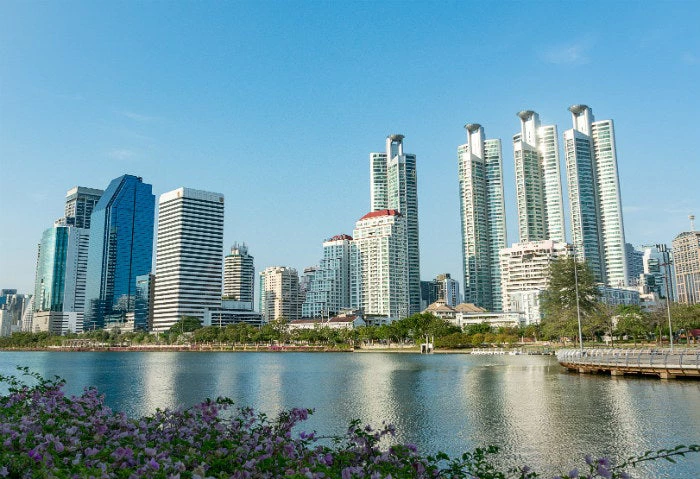
Global experience shows that growing first and cleaning up later rarely works. Rather, it is in countries’ interest to prioritize green and clean growth. This also holds true for Thailand, a country with rich natural resources contributing significantly to its wealth.
According to World Bank data, annual natural resource depletion in Thailand accounted for 4.4 percent of Gross National Income in 2012, and it has been rising rapidly since 2002. The rate of depletion is comparable to other countries in the East Asia and Pacific region, but it is almost three times faster than the rate in the 1980s.
Rapid natural resource depletion in Thailand is increasingly visible in reduced forest areas. Illegal logging and smuggling have led to a decline from 171 million rai of forested area in 1961 to 107.6 million rai in 2009. Coastal communities face erosion, ocean waste, and illegal, destructive fishing. The coasts are also increasingly vulnerable to storm surges and sea level rise, due to continued destruction of mangroves and coral reefs.
How does natural resource depletion affect people? The effects are ubiquitous, every day:
-
A Karen villager, for example, will have a more difficult time finding food and herbs to use as medicine in a forest that is disappearing.
-
A local operator or a boatman making a living from a diving business will face decline in his or her income as coral reefs bleaching becomes a more serious threat.
-
Some key tourist destinations may have to close temporarily for recovery or shut down completely.
-
As air pollution in Bangkok stays above the World Health Organization's recommended standard, it can cause breathing problems, respiratory diseases, and a range of adverse long-term health effects.
-
Only around 50 percent of wastewater is treated in Thailand, and communities along the river will risk using unsafe water for consumption. Urban residents must be concerned about the safety of food grown with contaminated water in food-producing areas.
But the future need not be bleak. On the contrary, the opportunities for Thailand to enjoy the benefits of sustainable growth are plenty! Such opportunities are outlined in a recent report by the World Bank. The Systematic Country Diagnostic report, Getting Back on Track: Reviving Growth and Securing Prosperity for All, includes some options for Thailand to make concrete progress on green growth.
How can Thailand enjoy economic growth and also protect the environment? Aware of the need for change, policymakers have put in place strategies to address dwindling natural resources. For example, a clear target has been set to increase forest coverage to 40 percent of the country’s total land area. Actions to accelerate identification and clarification of forest boundaries will be the first step to achieving this target. Investment in sustainable forest management is also important to increase forest areas – both public and private investment. Such investments have proven successful, for example, in Brazil.
Since 2012, regulations to keep in check water pollution have become more stringent. As is often the case elsewhere, the weakest link is enforcement. But simple steps can be taken by taking advantage of data. A real-time digital monitoring system can be put in place more to monitor pollution and wastewater discharges. Enforcement has improved with the introduction of monitoring systems for wastewater discharges at almost 300 large factories. Expanding the systems to strengthen enforcement further will be important – including sharing the data with the public, so citizens can play a more active role in enforcing the laws.
Putting a price on pollutants like carbon emissions can encourage firms and consumers to develop and use cleaner energy opportunities and technologies. Over 40 countries have started carbon pricing mechanism. Payments for environmental services where government pays nearby communities in return to protecting the forest, could also be considered.
Green growth is a driver of economic growth and job creation in other countries, such as South Korea and the United Kingdom, and it can be for Thailand too. The results of incentives for renewable energy producers has yielded encouraging results in the gradual growth of renewable energy production and use. About 44 billion baht in renewable investments are expected this year alone – investments that will lead to more jobs for the country. Still, there is scope for much further and faster renewable energy growth, especially solar energy.
What can people do? What can we do? Green growth and a clean country starts with us. We all can become more environmentally conscious consumers and contribute to a clean and green Thailand. For example, we can buy environmentally-friendly appliances, such as energy efficient light bulbs and refrigerators with less ozone-damaging coolants. We can also take shorter showers, reduce waste, especially plastic waste, and recycle at home. And we can engage in public debate to support policies and projects that are good for the environment.
Thailand is on the right track in addressing its key energy and environmental challenges. Greener growth will be critical for ensuring the availability of resources to power future growth, and for protecting Thailand’s wealth of natural resources for generations to come.
A version of this blog appeared in Krungthep Turakij.


Join the Conversation